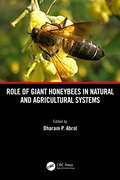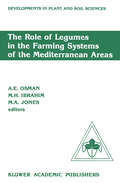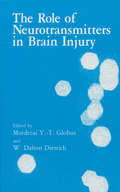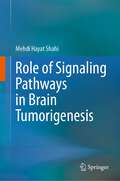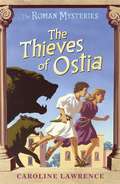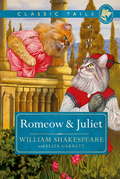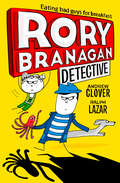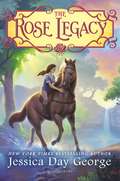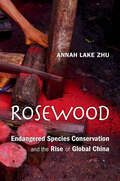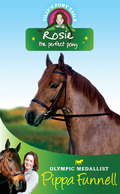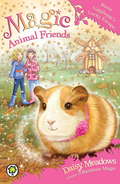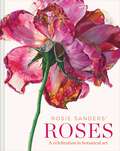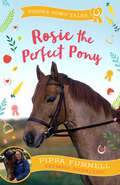- Table View
- List View
Role of Giant Honeybees in Natural and Agricultural Systems
by Dharam P. AbrolRole of Giant Honeybees in Natural and Agricultural Systems provides multidisciplinary perspective about the different facets of giant honeybees. Giant honeybees–Apis dorsata and Apis laboriosa are excellent pollinators of crops, fruits, and vegetables in cultivated and natural lanscapes. Their large size, long foraging range, and large work force make them the most spectacular of all honeybee species for crop pollination and honey production. Due to their decline, ecosystems and global food security are being threatened. This book is the first of its kind which deals in detail on varied aspects of giant honeybee biology, management, conservation strategies for protecting biodiversity and enhancing crop productivity. It aims to promote a large, diverse, sustainable, and dependable bee pollinator workforce that can meet the challenge for optimizing food production in 21st century. SALIENT FEATURES: Covers the latest information on various aspects of biology of giant honeybees and brings the latest advances together in a single volume for researchers and advanced level students Provides an excellent source of advanced study material for academics, researchers and students and programme planners Provides an excellent source of livelihood in mountainous areas and marginal farmers Deals with biology, management and conservation strategies for protecting biodiversity and enhancing crop productivity. Excellent pollinator of tropical and subtropical crops, fruits, vegetables, etc. less prone to diseases and enemies This book will be useful for pollination biologists, honeybee biologists, scientists working in agriculture, animal behavior, conservation, biology, ecology, entomologists, environmental biologists, etc.
Role of Giant Honeybees in Natural and Agricultural Systems
Role of Giant Honeybees in Natural and Agricultural Systems provides multidisciplinary perspective about the different facets of giant honeybees. Giant honeybees–Apis dorsata and Apis laboriosa are excellent pollinators of crops, fruits, and vegetables in cultivated and natural lanscapes. Their large size, long foraging range, and large work force make them the most spectacular of all honeybee species for crop pollination and honey production. Due to their decline, ecosystems and global food security are being threatened. This book is the first of its kind which deals in detail on varied aspects of giant honeybee biology, management, conservation strategies for protecting biodiversity and enhancing crop productivity. It aims to promote a large, diverse, sustainable, and dependable bee pollinator workforce that can meet the challenge for optimizing food production in 21st century. SALIENT FEATURES: Covers the latest information on various aspects of biology of giant honeybees and brings the latest advances together in a single volume for researchers and advanced level students Provides an excellent source of advanced study material for academics, researchers and students and programme planners Provides an excellent source of livelihood in mountainous areas and marginal farmers Deals with biology, management and conservation strategies for protecting biodiversity and enhancing crop productivity. Excellent pollinator of tropical and subtropical crops, fruits, vegetables, etc. less prone to diseases and enemies This book will be useful for pollination biologists, honeybee biologists, scientists working in agriculture, animal behavior, conservation, biology, ecology, entomologists, environmental biologists, etc.
The Role of Legumes in the Farming Systems of the Mediterranean Areas: Proceedings of a Workshop on the Role of Legumes in the Farming Systems of the Mediterranean Areas UNDP/ICARDA, Tunis, June 20–24, 1988 (Developments in Plant and Soil Sciences #38)
by A. E. Osman M. M. Ibrahim M. A. JonesLegumes are an important source of protein for humans and animals. They provide nutritionally rich crop residues for animal feed, and playa key role in maintaining the productivity of soils particularly through biological nitro gen fixation. They are, therefore, of immense value in rainfed farming systems. The International Center for Agricultural Research in the Dry Areas (ICARDA) has a responsibility for research on food, pasture, and forage legumes. The Center also has the broad objective of improving livestock production in rainfed farming systems. Although food legumes have be~n known and grown by farmers in the WANA region for a long time, their productivity has remained low and variable. Forage legumes, on the other hand, are not so well known by farmers of the region, and their role in the farming systems is not so well understood. Thus, we need to develop the concept of using forage legumes as crops and to fit them into cropping systems. In its efforts to increase the productivity of food legumes and develop the legume-based crop/livestock systems, ICARDA has established a network of scientists in the different National Agricultural Research Systems in the region. To further strengthen this network, ICARDA convened a workshop on 'The Role of Legumes in the Farming Systems of Mediterranean Areas' in Tunis, Tunisia, 20-24 June 1988. This workshop was co-sponsored by UNDP, who also contributed funds for this publication.
The Role of Microenvironment in Axonal Regeneration: Influences of Lesion-Induced Changes and Glial Implants on the Regeneration of the Postcommissural Fornix (Advances in Anatomy, Embryology and Cell Biology #137)
by Christine C. Stichel-GunkelSince the pioneering studies of Ramon y Cajal the inability of lesioned adult CNS axons to regenerate has been well established. During the past years advancements in molecular, cellular and biochemical knowledge have provided new insights into the extrinsic mechanims underlying regeneration failure. The rapid progress in this field has already led to the development of new concepts for therapeutic manipulations. This book provides a comprehensive overview of structural and molecular changes induced by an invasive CNS lesion and their involvements in regeneration processes. Moreover, it demonstrates the strong growth-promoting actitivies of implanted glial cells. The data is discussed in relation to current knowledge on the mechanisms of axonal degeneration and regeneration and in terms of their relevance for the development of novel therapeutic strategies.
The Role of Neurotransmitters in Brain Injury
by W. D. Dietrich M. Y. T. GlobusNeuroscientists from various disciplines have given extraordinary attention to the role of neurotransmitters in the field of neuronal injury. This volume summarizes the original oral and poster contributions which were presented at the symposium, "The Role of Neurotransmitters in Brain Injury," in Key West, Florida, between June 7-9, 1991. This symposium was the official Satellite of Brain-91, the Fifteenth International Symposium on Cerebral Blood Flow and Metabolism, held in Miami the previous week. The two principal goals of the Key West satellite meeting were to document recent progress and, more importantly, to explore future directions for investigative studies of the role of neurotransmitters in brain injury. To achieve these goals we assembled participants from diverse scientific fields and specialties who brought their collective expertise to discussions on the importance of neurotransmitters in neuronal and vascular injury following brain ischemia, trauma, and epilepsy. Their contributions are reflected in this volume. An important section of this volume is devoted to the role of glutamate and glutamatergic receptors in the development of ischemic neuronal damage. Topics covered include the mechanisms of glutamate and other excitatory amino acids, and the role of underlying injury-induced release different glutamatergic receptors in brain injury, including the NMDA and the non-NMDA receptors. The involvement of other neurotransmitters in the process of ischemic brain injury is well established.
The Role of Organismal Oxidative Stress in the Ecology and Life-History Evolution of Animals (Fascinating Life Sciences)
by David CostantiniThis book illustrates the role of cellular oxidative stress as one of the most important physiological cornerstones in the evolution of biodiversity. The first part of the book provides the fundamentals to navigate the field and analyse the cross-talk between oxidative status homeostasis and other fundamental organismal functions, such as immunity and stress physiology. The second part of the book argues that oxidative stress underpins the astonishing diversity of adaptations to the environments and the evolution of life-history strategies, from growth to reproduction. Unravelling the (un)expected ways through which the need of regulating the organismal oxidative status has influenced the evolution of life, this book presents a novel integrative way of thinking about how a cellular mechanism has shaped the evolution of life and death.
Role of Signaling Pathways in Brain Tumorigenesis
by Mehdi Hayat ShahiThis book provides acomprehensive overview of cell signalling pathways and morphogens in the genesis of brain tumours. It also explains the role of brain tumour stem cells in the brain tumour progression. It also elucidates the novel early biomarkers that can be utilized to diagnose brain tumours. It presents the basic developmental pathways and morphogens, including retinoic acid and TGF-b that promote brain tumorigenesis. The chapters illustrate the role of stem cells and stem cells mediated cell signalling pathways including, Sonic hedgehog, Notch, Wnt in the brain tumour growth. The chapters also emphasize the role of transcription factors, mainlyNanog, Sox, BMI1, HIF1 and Pax6 in the brain tumouriogensis. It highlights the role of NF-kb, Myc and neurotrophins in the brain tumour development. Finally, the book summarizes the potential early therapeutic targets and targeted drug discovery for brain tumours.
Role of the Choroid Plexus in Health and Disease (Physiology in Health and Disease)
by Jeppe Praetorius Bonnie Blazer-Yost Helle DamkierThis book highlights the importance of the choroid plexus, which forms the blood-cerebrospinal fluid barrier and is the site of the major production of the cerebrospinal fluid (CSF). The authors show that this barrier is crucial for maintaining important compositional differences between the blood plasma and the CSF. The choroid plexus epithelial cells also prevent the spread of infectious agents and other blood-borne entities to the brain tissue. Chapter topics range from the production of CSF by electrolyte regulation in the choroid plexus, to details on the selectively transporting nature of this barrier. Further, the authors elaborate on the important roles of CSF in sustaining brain health by providing hydration, solutes, and nutrients to the brain tissue. Readers will also learn how CSF circulates signaling molecules within the compartments of the brain and removes waste products from the brain tissue. Elucidating the regulation of these processes in the choroid plexus is not only important for the readers’ understanding of normal brain development and function, but is also crucial for resolving a variety of cerebral challenges that lead to brain edema, as well as developing treatments for diseases. The book discusses disease models like hydrocephalus, sleep disorders, and age-related dementia. Its comprehensive coverage makes this volume a valuable resource for researchers in cell and neurophysiology, as well as graduate students of the neurosciences.
The Roman Mysteries: Book 1 (PDF)
by Caroline LawrenceThe first in Caroline Lawrence's internationally bestselling Roman Mysteries series, re-issued with a fantastic new cover look. Flavia Gemina is a natural at solving mysteries. The daughter of a ship's captain living in Ostia, the port of Rome, in AD79, she and her three friends, Jonathan, a Jewish boy (and secretly a Christian); Nubia, an African slave girl; and Lupus, a mute beggar boy, must work together to discover who is beheading the watchdogs that guard people's homes, and why. A talented storyteller, Caroline Lawrence has created a delightfully readable and accessible series that children will want to read time and time again.
Romeis - Mikroskopische Technik
by Maria Mulisch Ulrich WelschDer ROMEIS ist seit fast 100 Jahren das Standardwerk der mikroskopischen Technik. Über 18 Auflagen hat dieses Methodenbuch die Entwicklung der lichtmikroskopischen Verfahren begleitet und ist bis heute ein unverzichtbares Laborhandbuch für Wissenschaftler und Studierende, die auf den Gebieten der Cytologie, Histologie, mikroskopischen Anatomie, Pathologie und Histochemie forschen. Der Inhalt der 19. Auflage des ROMEIS wurde aktualisiert und um viele moderne Methoden und Anwendungen der Mikroskopie erweitert.Unter der Herausgeberschaft von Privatdozentin Dr. Maria Mulisch und Professor Dr. med. Ulrich Welsch haben 24 Experten der Mikroskopie aus Forschung und Industrie ihre Erfahrung eingebracht, um dieses Werk zu einem Arbeitsbuch zu machen, auf das man sich beziehen und verlassen kann.
Romeis - Mikroskopische Technik
by Maria Mulisch Ulrich WelschDer ROMEIS ist seit fast 100 Jahren das Standardwerk der mikroskopischen Technik. Über 17 Auflagen hat dieses Methodenbuch die Entwicklung der lichtmikroskopischen Verfahren begleitet und ist bis heute ein unverzichtbares Laborhandbuch für alle Mediziner, Biologen, Mikrobiologen und Chemiker, die cytologische, histologische, pathologische oder histochemische Forschung betreiben. Der Inhalt der 18. Auflage des ROMEIS wurde aktualisiert und um viele moderne Methoden und Anwendungen der Mikroskopie erweitert.
Romeow and Juliet: Beautifully illustrated classics, as told by the finest breeds! (Classic Tails)
by William Shakespeare GarrettCLASSIC TAILS - the greatest works of literature, as told by the finest breedsWe all have our favourite classic tales; books that have been beloved to us since childhood, whose wonderful stories and rich tapestry of characters are unsurpassed in modern literature. How, you may ask, could these marvellous works ever be improved upon?Reader, ask no more...for we present Romeow and JulietYou've never read Shakespeare like this, till now: / The tragedy of Juliet, and her Romeow.In fair Purrona, two furry families, the Montamews and the Cattulets, are at war. But when Romeow, the son of Montamew, crashes a Cattulet party, he falls in love with his enemy's daughter, Juliet. So begins the tale of two star-crossed kitties, who must defy this feline feud to live - and tragically die - together.What readers are saying about Romeow and Juliet:'A light-hearted catty take on Romeo and Juliet - a great one to pick up for Christmas!' 'This is such a beautiful and wonderful book to own and perfect for anyone, no matter if you've read Shakespeare of not!' '5 stars. Loving this - and the other books in the series'
Rory Branagan (Rory Branagan #1)
by Andrew CloverMeet RORY BRANAGAN – he eats bad guys for breakfast. Well, not ACTUALLY. But he IS the best detective in town. First in a hilarious seven-book comedy-crime series for readers of 8+.
Rosa and the Daring Dog
by Megan RixHOWLY is a tiny puppy, left abandoned in a trash can next to a school.EDDIE is the young girl who finds him . . .Eddie is immediately drawn to the puppy, whose bravery and determination remind her of a very famous person indeed.Eddie's class are learning about Mrs Rosa Parks, whose act of courage on a bus in 1955 started a whole movement against racism in America. Mrs Parks herself soon visits Eddie's school, and when the great lady points out a stark reminder of racism in the school's own playground it's up to Eddie, her friends, and their new school dog Howly to remind everyone how to stay hopeful and stand up for what is right.
The Rose Legacy (Rose Legacy)
by Jessica Day GeorgeWhen orphaned Anthea Cross-Thornley receives a letter from a long-lost uncle, she wonders if she will finally find a true home. But she is shocked to learn that her uncle secretly breeds horses--animals that have been forbidden in her kingdom for centuries. More alarming is Anthea's strange ability to sense the horses' thoughts and feelings, an ancient gift called The Way. Confused and terrified, Anthea is desperate to leave, but when her family and kingdom are put at risk, can she embrace The Way and the exciting future it might bring her?This sweeping, emotionally-resonant fantasy from beloved author Jessica Day George is perfect for fans of Princess Academy and Black Beauty.
Rosewood: Endangered Species Conservation and the Rise of Global China
by Annah Lake ZhuA riveting study of the booming rosewood trade between China and Madagascar uncovers an alternative approach to environmentalism that disrupts Western models. Rosewood is the world’s most trafficked endangered species by value, accounting for larger outlays than ivory, rhino horn, and big cats put together. Nearly all rosewood logs are sent to China, fueling a $26 billion market for classically styled furniture. Vast expeditions across Asia and Africa search for the majestic timber, and legions of Chinese ships sail for Madagascar, where rosewood is purchased straight from the forest. The international response has been to interdict the trade, but in this incisive account Annah Lake Zhu suggests that environmentalists have misunderstood both the intent and the effect of China’s appetite for rosewood, causing social and ecological damage in the process. For one thing, Chinese consumers are understandably seeking to reclaim their cultural heritage, restoring a centuries-old tradition of home furnishing that the Cultural Revolution had condemned. In addition, Chinese firms are investing in environmental preservation. Far from simply exploiting the tree, businesses are carefully managing valuable forests and experimenting with extensive new plantings. This sustainable-use paradigm differs dramatically from the conservation norms preferred by Western-dominated NGOs, whose trade bans have prompted speculation and high prices, even encouraging criminal activity. Meanwhile, attempts to arm conservation task forces—militias meant to guard the forests—have backfired. Drawing on years of fieldwork in China and Madagascar, Rosewood upends the pieties of the global aid industry. Zhu offers a rigorous look at what environmentalism and biodiversity protection might look like in a world no longer dominated by the West.
Rosie: Book 3 (Tilly's Pony Tails #3)
by Pippa FunnellMeet Tilly Redbrow, who doesn't just love horses - she lives, breathes and dreams them too! Tilly spends every spare minute at Silver Shoe Farm getting to know rescue horse Magic Spirit. But she longs for a pony of her own. Then her friend Cally has some surprising news and Tilly realises that sometimes good things happen when you least expect...From Pony Club to riding for the British team, and for every girl who has ever longed for a pony of her own, these delightful, warm and engaging stories are packed with Pippa Funnell's expert advice on everything you ever wanted to know about horses.
Rosie Gigglepip's Lucky Escape: Book 8 (Magic Animal Friends #8)
by Daisy MeadowsWelcome to a magical world where animals talk and play - just like you and me!There's a wild wind blowing in Friendship Forest, as Grizelda's storm dragon takes over the magical windmill that controls the forest's breezes!Lily and Jess must help little guinea pig Rosie rescue her family and save the forest - before Grizelda takes over once and for all!
Rosie Sanders' Roses: A celebration in botanical art
by Rosie SandersAward-winning and hugely popular artist Rosie Sanders showcases the beauty of the rose in her follow up to Rosie Sanders Flowers. Over 80 stunning paintings and sketches are shown for the first time. The artist writes a personal letter on each of her rose paintings (to be given unopened to the final recipient or buyer of the painting). Many of these personal letters sit alongside the paintings, as they explain the creative and emotional process she went through to create it. The book is a revealing insight into the artist's muse and the author's sketches and drawings are also included to show the full artistic process. The book is introduced by an extended essay on the resonance of the rose – all across the world – in our art, literature, poetry, folklore and gardens. The rose emblem is timeless and this book not only celebrates its beauty in art but tells the story of the rose as one of nature's most powerful motifs.
Rosie the Perfect Pony (Pippa's Pony Tales)
by Pippa FunnellBook 3 in a series of heart-warming pony tales packed with expert advice from three-times Olympic Medallist and Grand Slam winner, Pippa Funnell, on everything you ever wanted to know about horses.Every waking moment is about horses for pony-mad Tilly. She lives and breathes pony books and magazines and at night she dreams of ponies. At Silver Shoe Farm she is getting to know Magic Spirit better and better and growing in confidence with him. She's also enjoying making new friends both human and, with the arrival of Rosie, the perfect pony, animal ones too.Collect all 18 titles in this series of irresistible, uplifting pony adventures, packed with expert, up-to-date advice from the author as well as a helpful glossary and black and white illustrations. For 8+
Rotifer Symposium VI: Proceedings of the Sixth International Rotifer Symposium, held in Banyoles, Spain, June 3–8, 1991 (Developments in Hydrobiology #83)
by John Gilbert E. Lubzens M. R. MiracleAs in previous symposia, some current research topics were selected for review and eight invited papers were presented. For the first time a paper was presented on the historical aspects of Rotiferology, covering European research between 1680-1950. A special workshop session was devoted to a debate on a controversial topic: Rotifer Phylogeny. The workshop resulted in a very successful discussion and the integration of scattered evidence and hypotheses on the phylogenetic origin of rotifers, the relationships between major rotifer groups, and the mechanisms of evolution.
Rotifera IX: Proceedings of the IXth International Rotifer Symposium, held in Khon Kaen, Thailand, 16–23 January 2000 (Developments in Hydrobiology #153)
by La-Orsri Sanoamuang Hendrik Segers Russell J. Shiel Ramesh D. GulatiThis volume is a record of the proceedings of the IXth International Rotifer Symposium, which was held in Khon Kaen, Thailand, on January 16-23, 2000. The symposium was the first meeting of the international group of rotifer researchers held in Asia. The volume contains reviews and research papers dealing with diverse aspects of scientific research related to Rotifera and their ecology. Some of the topics addressed are: taxonomy and zoogeography, ecology, phylogeny and evolution, physiology, biochemistry and population genetics, aquaculture, and ecotoxicology. This book is special because it contains a unique compilation of contemporary rotifer-related research, and is the eighth of a series of rotifer symposium proceedings published in Developments of Hydrobiology. This update of Rotifera studies will be of great interest to invertebrate zoologists, hydrobiologists, ecologists, and aquaculturists, particularly those interested in freshwater habitats.
Rotifera VII: Proceedings of the Seventh Rofifer Symposium, held in Miko?ajki, Poland, 6–11 June 1994 (Developments in Hydrobiology #109)
by J. Ejsmont-Karabin R. M. PontinThe Proceedings of the Seventh International Rotifer Symposium, Rotifera VII, spans subjects from community ecology through biochemistry, from the most basic science through the most clearly applied technology. Some papers report exceptional progress in our knowledge of rotifer anatomy and biochemistry, as well as rotifer molecular biology, evolution and life histories. The book also contains an interesting article describing a hundred years of Polish contributions to rotiferology as well as papers discussing both general patterns of rotifer biogeography and rotifer distribution in different habitats, together with many aspects of the ecology of rotifer species, populations and communities. Audience: This update on rotifer taxonomy, biology and ecology will be of great interest to zoologists, especially hydrobiologists studying the structure and function of freshwater zooplankton.
Rotifera VIII: Proceedings of the VIIIth International Rotifer Symposium, held in Collegeville, Minn., U.S.A., 22–27 June 1997 (Developments in Hydrobiology #134)
by E. Wurdak R. Wallace Hendrik SegersRotifera VIII: A Comparative Approach is a record of the proceedings of the VIIIth International Rotifer Symposium which was held in Collegeville, Minnesota, USA, on June 22-27, 1997. It contains review papers and reports of recent research findings along with the presentation of new methods in rotifer biology. The publications contained in this volume reflect the wide diversity of approaches, methods of analysis and conclusions that characterize research on the Rotifera. Some of the topics addressed are: rotifer distribution, responses to biotic and abiotic factors, genetic profile of individuals and populations, rotifer feeding and mating behavior, morphology, phylogeny and taxonomy. These studies will be of great interest to invertebrate zoologists and limnologists, particularly those interested in freshwater habitats.
Rotifera X: Rotifer Research: Trends, New Tools and Recent Advances (Developments in Hydrobiology #181)
by Alois Herzig Ramesh D. Gulati Christian D. Jersabek Linda MayThis volume reflects the latest developments in the research of a global community of rotifer researchers, who came together at Illmitz, Austria in 2003. Contributions are manifold and span fields from phylogeny and evolution of the phylum Rotifera to practical aspects of aquaculture and ecotoxicology. Major issues include phylogeny and evolution, genetics and molecular ecology, new aspects of rotifer anatomy through the application of confocal laser-scanning microscopy, anhydrobiosis, long-term studies in lakes and rivers, population dynamics and community ecology, trophic relationships between copepods and rotifers, alongside biodiversity studies based on classical taxonomic concepts and molecular approaches. Although primarily focussed on one taxonomic group, the scientific outcome of this meeting is of relevance to the study of other aquatic microinvertebrates as well.
